Kalila wa-Dimna: T-S Ar.6.321 part of the Arabic book Kalila wa Dimna, story nine – ʾIlāḏ, Balāḏ and Iirāḵt
Mohamed Ahmed, Trinity College Dublin
Kalila wa-Dimna book is a collection of exciting moral stories written in a unique style both in terms of narration and its technique of maintaining suspense. The stories in Kalila wa-Dimna are based on an imaginary dialogue between animals, and each story holds another internal story, which holds another and so on. The book dates back roughly to the 3rd/4th century BCE, and it was originally written in Sanskrit. In the 8th century, the book was translated into Arabic by ʿAbd Allāh ibn al-Muqaffaʿ (died ca. 756 or 759 AD). The original Persian copy has been lost though. The book eventually became exceptionally popular throughout the world, which resulted in various copies and many translations, of which Hebrew, French and Greek were among the oldest translations, made around the 13th and 14th centuries.
The Arabic manuscript under the classmark Arabe 3465, which is currently held in Paris, in the Bibliothèque Nationale de France, Département des manuscrits, is considered one of the oldest Arabic copies left of this famous book. It dates to the early 13th century (1220 CE). The Cairo Genizah should be considered a plentiful source for the study of Arabic literature. It holds fragmentary works and numerous pieces of otherwise lost Arabic literary texts. And Kalila wa-Dimna is no exception, for instance, the well-known fragment T-S Ar.51.60, which holds an illustration from a magnificent copy of the book of Kalila wa-Dimna.
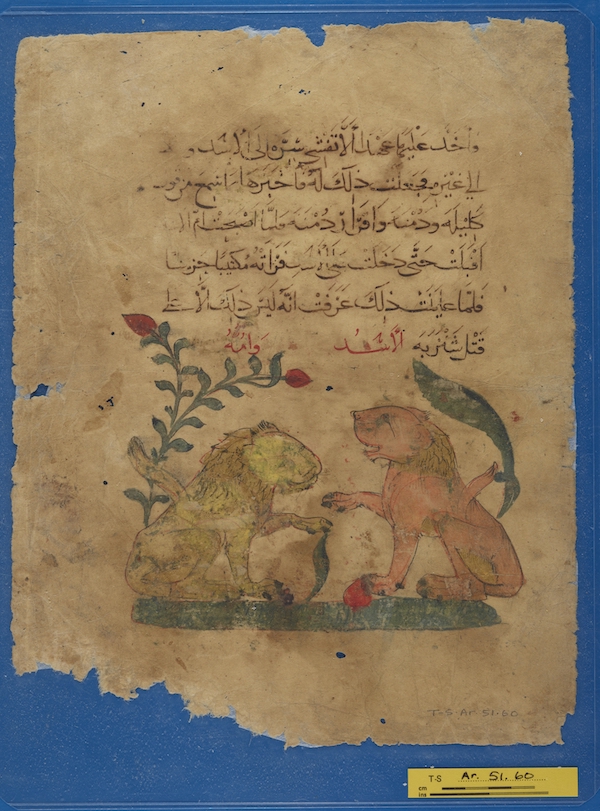
T-S Ar.51.60 recto
The Shivtiel and Niessen catalogue of the T-S New Series (2006) spotted a single bifolium of Kalila wa-Dimna in Judaeo-Arabic, T-S NS 97.16, copied probably in the 12th-13th c.

Detail of T-S NS 97.16 verso
The new fragment for this month is T-S Ar.6.32. Its discovery doubles the number of known copies of the work that are written in Arabic in Hebrew characters in the Genizah. A more extensive find, it consists of 6 leaves (3 bifolia), including headings of sections/chapters. This fragment was apparently part of a complete copy of the book of Kalila wa-Dimna in Judaeo-Arabic, which is now lost. Comparing the text in T-S Ar.51.60 to the Paris Arabic manuscript (BNF Arabe 3465), the author of this article was able to identify that the Genizah fragment preserves text from the story of ʾIlāḏ, Balāḏ and Iirāḵt, story nine in the Arabic Kalila wa-Dimna.
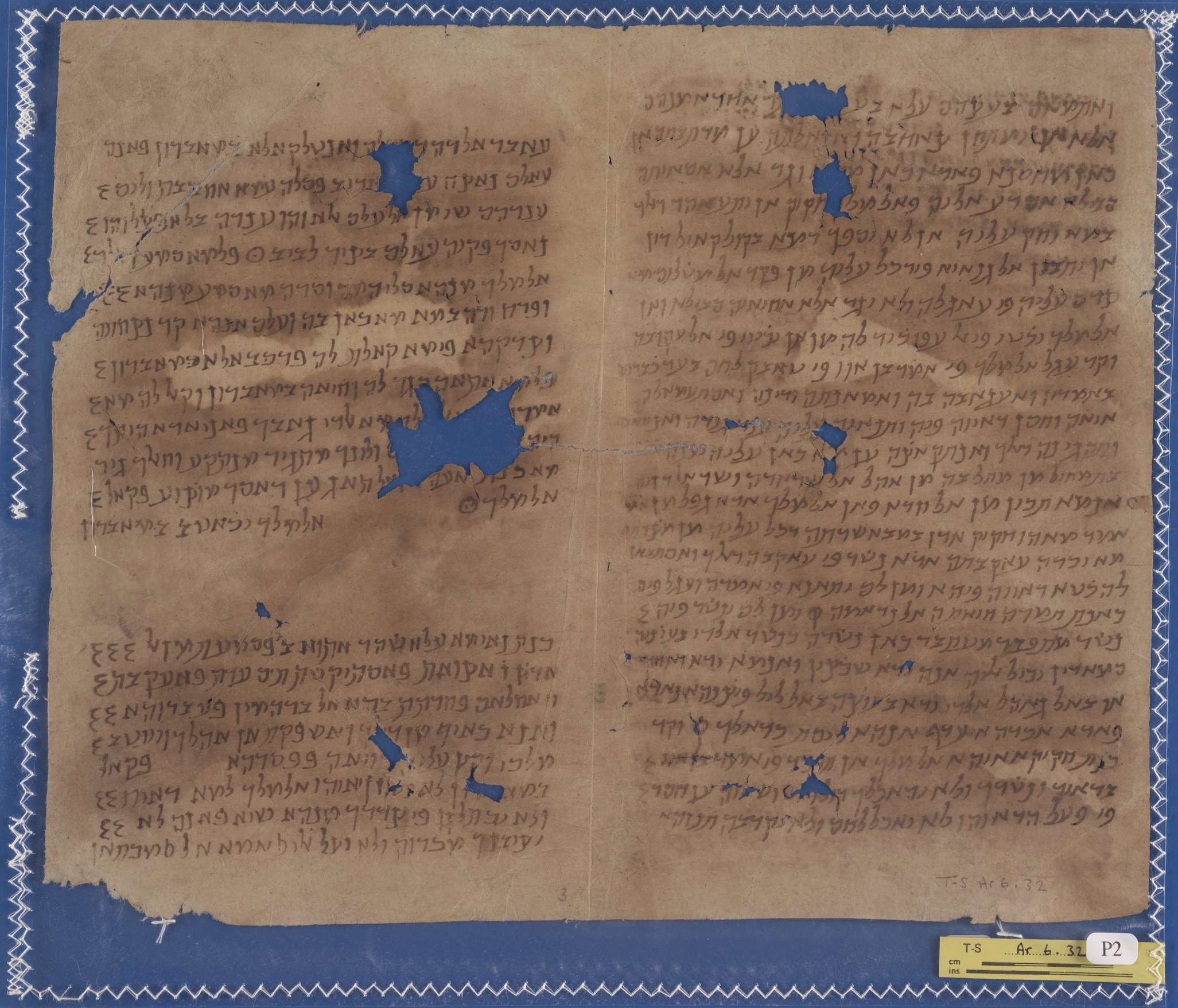
T-S Ar.6.32 P2 recto
Reading some lines of the Judaeo-Arabic text, one can easily identify various differences in comparison to the oldest Arabic copy preserved in Paris. To give an example, I compare here some lines from the two copies, first giving the Genizah fragment in its original form alongside a transcription into Arabic script:
T-S Ar.6.32 P2 f. 2 recto
| Translation | Arabic Script | Hebrew Script | Line |
|---|---|---|---|
| The king addresses Bmābrūn: |
الملك يخاطب بمابرون |
אלמלך יכׄאטב בּמאברון |
13 |
| “I was asleep on the back of my clothes until I heard six voices |
كنت نايما علا ظهر أتوابي فسمعت من الـ |
כנת נאימא עלא טׄהר אתואבי פסמעת מן אל |
14 |
| coming from the ground. Then I continued my sleep |
أرض ٦ أصوات فاستيقظت ثم عدت فأعقبت |
ארץׄ ו אצואת פאסתיקטׄת תֹם עדת פאעקבת |
15 |
| and I had 8 dreams, which I told the Brahmin about. They interpreted them for me |
٨ أحلام فحدثت بها الـ برهمين فعبروها |
ח אחלאם פחדתת בהא אל ברהמין פעברוהא |
16 |
| and I am worried about this, and I did not wish to be extinct and to lose my |
وأنا خايف من د[لـ]ـك وأشفقت أن أهلك ويعطب |
ואנא כאיף מן ד[ל]ך ואשפקת אן אהלך ויעטב |
17 |
| kingdom”. He told him about his dream, and so Bmābrūn interpreted it |
ملكي وقص عليـ[ـه ر]وياه ففسرها |
מלכי וקץ עלי[ה ר]ויאה פפסרהא פקאל |
18 |
| for him: “You should not be sad, my Lord, for what you saw, |
بما[برو]ن لا [تحـ]ـزن يا يهو الملك لما رأيت |
במא[ברו]ן לא [תח]ון יא יהו2 אלמלך למא ראית |
19 |
| and you should not let worries arise in your heart because of this dream. Because, there is nothing |
ولا يختلجو في صدرك منها شيا فانه لا |
ולא יכתלגו פי צדרך מנהא שיא פאנה לא |
20 |
| going to harm you or reach you. As for the two fishes… |
يصيبك مكروه ولا يصل اليك أما السمكتان |
יציבך מכרוה ולא יצל אליך אמא אל סמכתאן |
21 |
When comparing the above Judaeo-Arabic text to the oldest version in Arabic script (BNF Arabe 3465), we find the same part of the story in the following pages:
BNF MS. Arabe 3465, f. 132r:
فقال له الحكيم: ما بالك أيها الملك وما لي
أراك متغير اللون فقال له الملك إني رأيت في المنام ثمانية أحلام فقصصتها
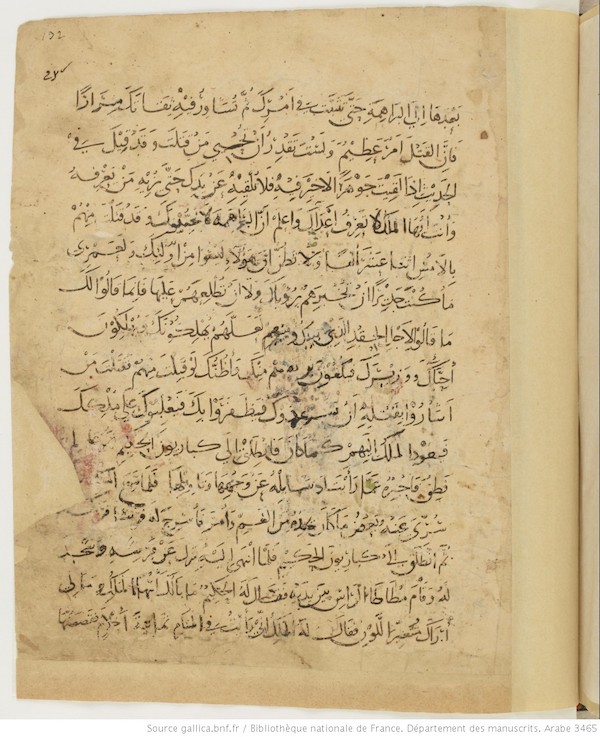
BNF MS. Arabe 3465, f. 132r, reproduced from gallica.bnf.fr / Bibliothèque nationale de France.
BNF MS. Arabe 3465, f. 132v:
على البراهمة وأنا خائف أن يصيبني من ذلك عظيم أمر مما سمعت
من تعبيرهم لرؤياي وأخشى أن يغصب مني ملكي أو أن أغلب عليه فقال
له الحكيم إن شئت اقصص علي احلامك وان شئت قصصتها عليك واخبرتك
بما رايت جميعه قال الملك بل من فيك اخبر فقال لا يحزنك أيها الملك هذا
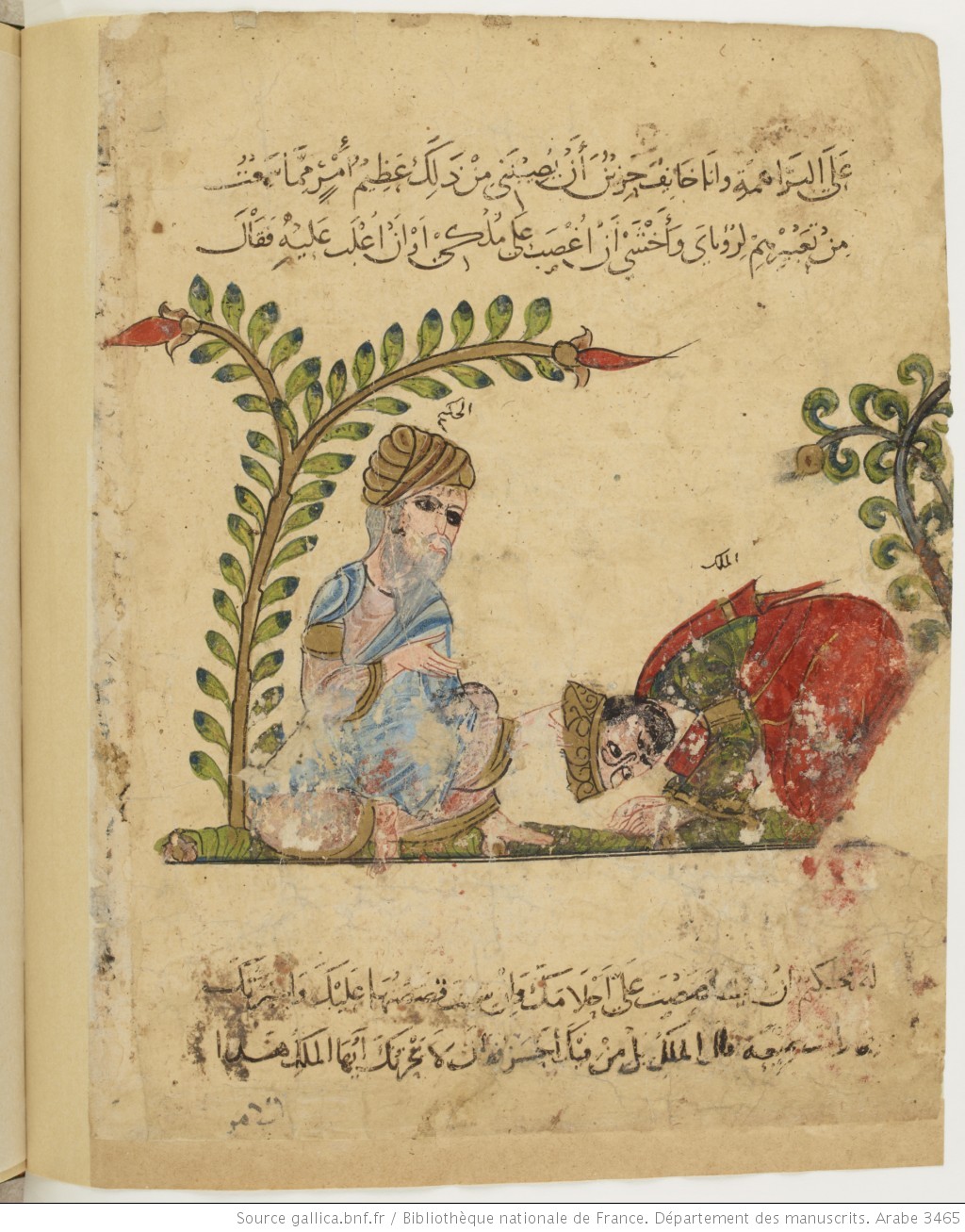
BNF MS. Arabe 3465, f. 132v, reproduced from gallica.bnf.fr / Bibliothèque nationale de France.
BNF MS. Arabe 3465, f. 133r:
الأمر ولا تخف منه أما تفسير السمكتين ...
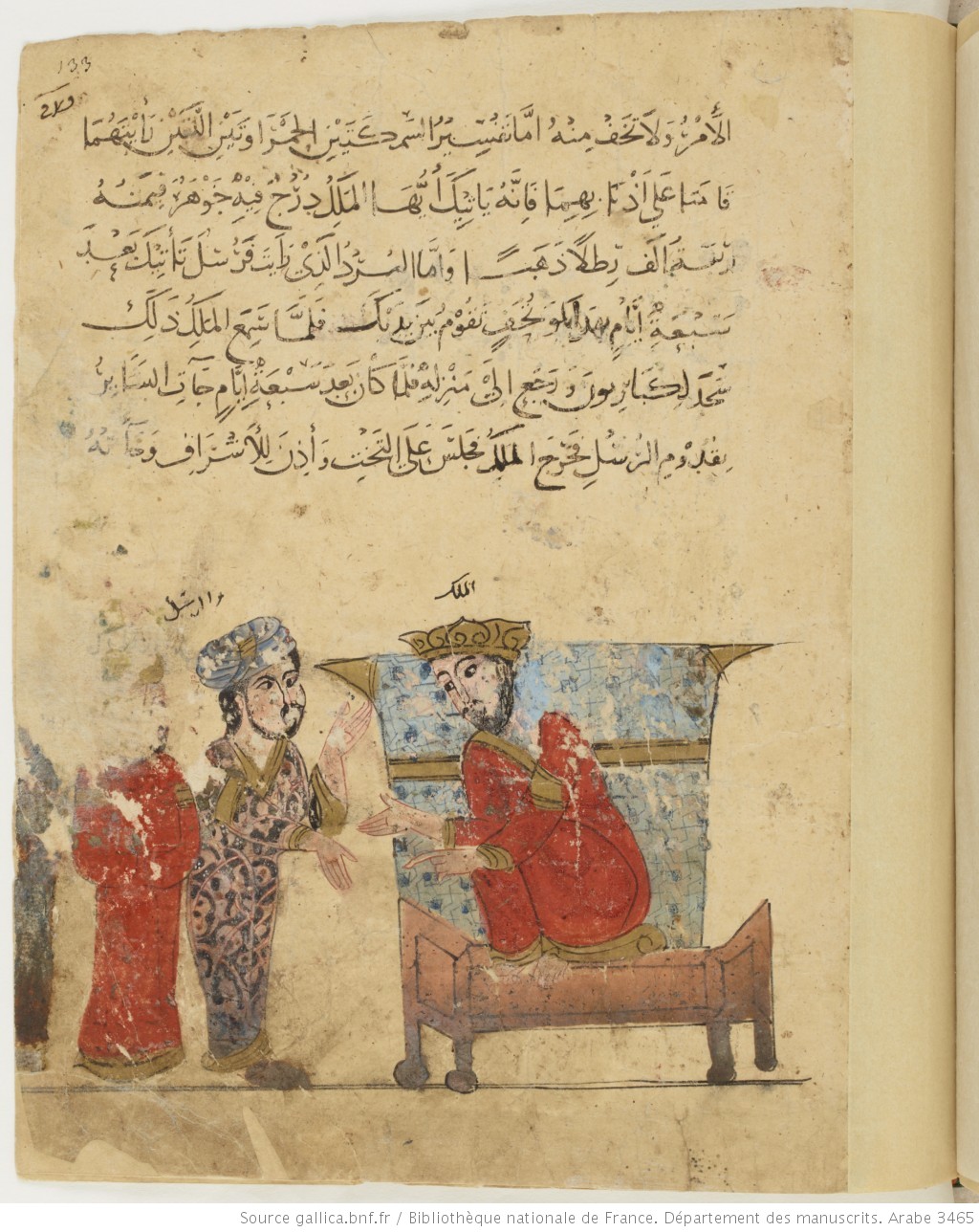
BNF MS. Arabe 3465, f. 133r, reproduced from gallica.bnf.fr / Bibliothèque nationale de France.
Although the main storyline remains the same in the two versions, the comparison reveals that there are considerable instances of differences between the two texts. Personal names are among the main differentiators here. Take for example the name of the wise man (al-Ḥakīm), who was called كباريون Kbāryūn in the Arabic-script MS, and he takes the name בּמאברון Bmābrūn in the Genizah fragment T-S Ar.6.32. This is not the only name that is distinctive in the two versions. The main character in the story holds two completely different names in the two versions too: she was called ايراخت Īrāḵt in the Arabic script, and אבלאד Ablād in the Hebrew script. The second distinctive feature found in the Judaeo-Arabic version is the incorporation of some Hebrew elements within the text. To give an example, the use of the Hebrew numbers in the text (ח אחלאם) or ‘8 dreams’, which is common in JA texts in general.
Hopefully, further investigation will reveal more distinctive features of the Judaeo-Arabic text. The initial analysis suggests that the JA text might apparently have been copied from another Arabic-script copy. Or it might be that it was directly translated into JA from a text written in a non-Arabic language. All in all, the JA version opens new avenues for questions about the original Kalila wa-Dimna text and the versions in which it was transmitted throughout the Middle Ages.3
Footnotes
1 The present author would like to thank Dr Ben Outhwaite for reading the draft of this FOTM.
2 Possibly could read as יא איהא אלמלך, meaning 'my Lord'.
3 The present author is working on a complete edition of the leaves under the classmark T-S Ar.6.32, with English translation and analysis.
This project has received funding from the European Research Council (ERC) under the European Union's Horizon 2020 research and innovation programme (grant agreement No. 851411 APCG).
Cite this artcile
Ahmed, M. (2021). Kalila wa-Dimna: T-S Ar.6.32 part of the Arabic book Kalila wa Dimna, story nine – ʾIlāḏ, Balāḏ and Iirāḵt. [Genizah Research Unit, fragment of the Month, February 2021]. https://doi.org/10.17863/CAM.82608
If you enjoyed this Fragment of the Month, you can find others here.
Contact us: genizah@lib.cam.ac.uk
The manuscripts in this article are part of the Cairo Genizah Collection in Cambridge University Library. To see more items from this collection visit: https://cudl.lib.cam.ac.uk/
